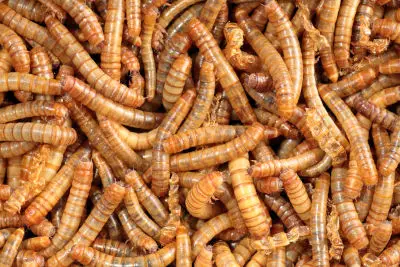Will a Blanket Keep a Reptile Warm? The Real Answer
Reptiles are known for their unique needs when it comes to their environment. One of the most important factors to consider is their temperature. Reptiles are cold-blooded creatures, which means they cannot regulate their own body temperature. Instead, they rely on external sources of heat to keep them warm. This raises the question: will a blanket keep a reptile warm?
Many reptile owners may wonder if covering their pet with a blanket will suffice in keeping them warm. While a blanket may provide some insulation, it may not be enough to maintain the proper temperature range for the reptile. Different species of reptiles have different temperature requirements, and it is important to ensure that their environment meets these needs. Using a thermometer to monitor the temperature in the enclosure is crucial in ensuring that the reptile is comfortable and healthy.
| Are these foods dangerous for your Beardie? | |
| Avacado? Click here to learn, from this guide, if this food is dangerous |  |
| Superworms? Click here to learn, from this guide, if this food is dangerous |  |
In this article, we will explore whether a blanket can keep a reptile warm, and what other methods can be used to maintain the proper temperature range in their environment. We will also discuss the potential risks of using a blanket as a heat source and offer alternative solutions to ensure the well-being of your reptile.
Understanding Reptile Biology
Reptiles are cold-blooded animals, meaning they rely on external sources of heat to regulate their body temperature. This is known as thermoregulation. Reptiles are ectothermic, which means that their body temperature is determined by the temperature of their environment.
Reptile Thermoregulation
Reptiles have a specific range of temperatures in which they can function properly. This range is known as their preferred temperature zone (PTZ). When a reptile is too cold, it will become lethargic and may not eat or move around much. When a reptile is too hot, it may become stressed, dehydrated, and may even die.
To maintain their PTZ, reptiles will move around and bask in the sun or under a heat source. They will also seek out cooler areas to avoid overheating. This behavior is known as behavioral thermoregulation.
Reptiles and Heat Sources
Reptiles require heat sources to maintain their PTZ. In the wild, they may bask in the sun or lie on warm rocks. In captivity, reptile owners provide heat sources such as heat lamps, heating pads, and ceramic heaters.
It’s important to provide a temperature gradient within the reptile’s enclosure, with a warm side and a cooler side. This allows the reptile to move between the two areas to regulate their body temperature.
While a blanket may provide some insulation, it is not a suitable heat source for reptiles. Reptiles require specific temperatures to thrive, and a blanket will not provide the necessary heat. It’s important to provide proper heat sources and temperature gradients to ensure the health and well-being of your pet reptile.
Role of Blankets in Reptile Warmth
Reptiles are cold-blooded animals that rely on external heat sources to regulate their body temperature. In captivity, it is important to provide them with a warm and comfortable environment to ensure their health and well-being. One common question that many reptile owners have is whether a blanket can be used to keep their pet warm.
Material and Insulation
Blankets can be an effective way to provide supplemental heat for reptiles, but it is important to choose the right material and insulation. Natural fibers such as wool or cotton can be good choices as they are breathable and can retain heat well. However, synthetic materials such as polyester can be dangerous as they can melt and release toxic fumes when exposed to high temperatures.
In terms of insulation, blankets with a high loft or thickness can provide better heat retention. It is also important to ensure that the blanket is not too heavy or thick, as this can prevent proper air circulation and lead to overheating.
Potential Risks
While blankets can be a useful tool for providing warmth to reptiles, there are also potential risks to consider. If a blanket is too close to a heat source or becomes too hot, it can pose a fire hazard. Additionally, if a reptile becomes entangled in a blanket, it can cause injury or even death.
It is important to monitor the temperature and placement of blankets to ensure the safety of both the reptile and the surrounding environment. In general, it is recommended to use specialized heating equipment such as heat lamps or heating pads designed specifically for reptiles.
Overall, while blankets can be a useful supplement to heating equipment, they should not be relied upon as the sole source of warmth for reptiles. Proper temperature regulation and monitoring is crucial for the health and well-being of these unique animals.
Alternative Ways to Keep a Reptile Warm
Reptiles are cold-blooded creatures that require warmth to maintain their body temperature. While blankets can provide warmth to humans, they are not an effective way to keep reptiles warm. There are several alternative ways to keep reptiles warm that are more effective and safe.
Use of Heat Lamps
Heat lamps are a popular way to keep reptiles warm. They emit heat and light, which can mimic the warmth of the sun. Heat lamps should be placed at one end of the enclosure to create a temperature gradient. This allows the reptile to move to a cooler area if it becomes too warm.
It is important to use the correct wattage bulb for the size of the enclosure. A bulb that is too powerful can overheat the enclosure and harm the reptile. It is also important to use a lamp holder that is designed for use with heat lamps.
Heated Rocks and Pads
Click here for the price, on Amazon #Ad
Heated rocks and pads are another option for keeping reptiles warm. They are designed to provide a warm surface for the reptile to rest on. They should be placed at one end of the enclosure to create a temperature gradient.
It is important to use a thermostat with heated rocks and pads to ensure that they do not become too hot. If they become too hot, they can burn the reptile. It is also important to choose a size that is appropriate for the size of the reptile.
In conclusion, blankets are not an effective way to keep reptiles warm. Heat lamps and heated rocks and pads are more effective and safe options. It is important to use the correct wattage bulb and lamp holder for heat lamps and to use a thermostat with heated rocks and pads.
